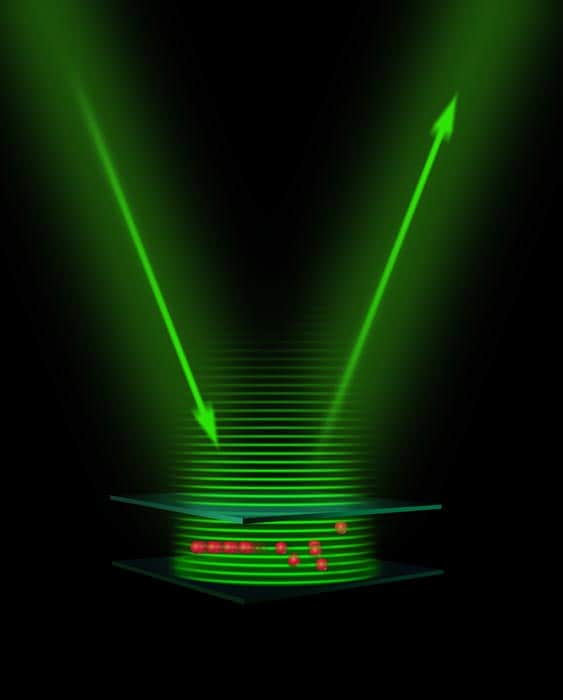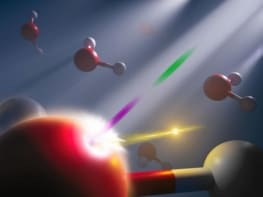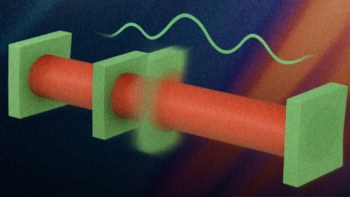
The idea that light can grab hold of objects may sound like science fiction, but optical tweezers that hold particles at a laser focus are widely used today. An even more fictional-sounding concept is the tractor beam – a beam of light or sound that can pull an object towards it. Over the past three years or so, physicists have shown that tractor beams are theoretically possible – and there has been a flurry of activity in the lab to try to build one. Now, researchers in the Czech Republic and the UK have produced a simple example using two laser beams. And as an unexpected bonus, they have also discovered a potentially powerful technique for sorting microscopic particles.
Optical tweezers can hold a particle still at the focus of a laser; but if you want to move the particle, you have to move the focus by, for example, adjusting a lens. In theory, a tractor beam is a beam of light that can reel in particles towards the source of the radiation without having to fiddle with foci. However, photons carry momentum, which can be transferred to a particle and therefore nudge it away from the source – something that seems to rule out a tractor beam.
However, in 2006 Philip Marston of Washington State University showed that there is a little flexibility. If the particle is irradiated with a specially shaped beam called a Bessel beam, consisting of wavefronts that form concentric circles centred on the object, then the recoil momentum that the particle acquires from scattering photons forward can exceed the momentum that it receives from the incoming photons. According to his calculations, the net force that the particle experiences can be directed back towards the light source.
No easy task
Actually creating a Bessel beam that can exert a pulling force over any significant distance is no easy task, however, because it would require an incredible amount of energy. As a result, tractor beams have remained a theoretical construct – although scientists such as physicist David Grier at New York University have constructed imaginative approximations.
In this latest research, physicists at the Institute of Scientific Instruments of the Academy of Sciences of the Czech Republic and the School of Medicine at the University of St Andrews have produced a simpler version of a tractor beam. It comprises two laser beams brought to a focus with a lens – a relatively simple geometry that can easily be made using a standard commercial microscope system. They found that by focusing the light inwards they could generate the same effect as if they had used a Bessel beam.
“Our geometry represents an alternative to the previously proposed optical fields based on Bessel beams” explains group leader Pavel Zemánek, “the concept allows larger extent of the tractor beam existence as well as controlling the polarization that plays a very important role”. The researchers managed to pull particles 30 μm, and could have gone further if they had used more powerful lasers.
Unexpected and useful effects
As an added bonus, the researchers found that the light had some unexpected and potentially very useful effects on the particles. For example, whether particles were pushed or pulled by the laser light depended on both the size of the particles and the polarization of the light. Light that was s-polarized, so that the electric field lay in the plane of the incident and reflected rays, was often found to pull particles of a particular size. On the other hand, light of the same wavelength that was p-polarized – where the electric field was perpendicular to the plane – would push it.
This allowed the researchers to devise a way of separating mixtures containing particles of two different sizes simply by switching the polarization of the light. The researchers also observed “optical binding”, whereby illuminated particles could be induced to stick together and self-arrange into various structures.
Polarization has potential
Optical physicist Miles Padgett of the University of Glasgow believes that the discovery of the polarization dependence is where the real interest of the work lies. “You would always expect some difference with polarization,” he says, “but the fact that the difference is big enough to do something with is the surprising thing.”
David Grier agrees. “This really is a clean demonstration of Marston’s principle in action,” he says. “It had to work, but it was really disappointing that it had not been made to work, given how many people had been working on it for so many years. But probably, going forward, the big long-term applications are using polarization to control self-organization and creating an extended light field that achieves sorting in the way that this does. And there it is not so much as a tractor beam but as the driving force for a lab-on-a-chip system.”
The research is published in Nature Photonics.



